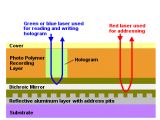HVDs, or Holographic Versatile Discs, are a type of optical digital data storing devices bearing a striking resemblance to the construction and operation of more common optical storing devices, such as CDs, DVDs and Blu-ray, relying on read/write techniques based on the principles of holography. Similar to typical optical data storing devices, the first holographic memory systems were created several decades ago; however, they did not became as popular as CDs and DVDs mostly because of the manufacturing costs involved and the complexity of the read/write processes.
Lately, holographic memory systems have started gaining more ground in relation to more common optical storing devices, as HVDs become cheaper to manufacture. After all, HVDs have both significantly superior storage capacity and read/write speeds.
A holographic memory is a device capable of storing information inside an object in the form of a three dimensional pattern, opposed to typical optical devices that store information on a spiral track represented by a series of 'bumps' and 'pits', which is basically a very long string of binary codes. Therefore, instead of recording data on a surface, HVDs are capable of storing information in a volume. This not only allows HVDs to store up to 20 times more information than a single Blu-ray, but also enables a data transfer rate 40 times faster than that of a standard DVD.
Practically, you can imagine HVDs as very fast multi-layered Blu-rays. Storing information in a volume of material is exactly why their name is almost synonymous with anonymous. Writing and reading the stored data is much trickier, requiring highly complex optical laser systems.
The servo data, used to track the position of the reader head over the disk, is no longer inserted between the stored information, as in the case of CDs, DVDs, but is recorded onto one of the substrates much in the same way as writing data on a CD. This implies the use of two laser systems, a red one to write and read the servo data and a green one for the holographic memory system, which are collimated into a single laser beam. This is also the reason why HVDs tend to be slightly thicker than typical optical storing devices, as they require two different recording mediums to store information, a substrate and a recording layer (for volumetric recording).

 14 DAY TRIAL //
14 DAY TRIAL // 
